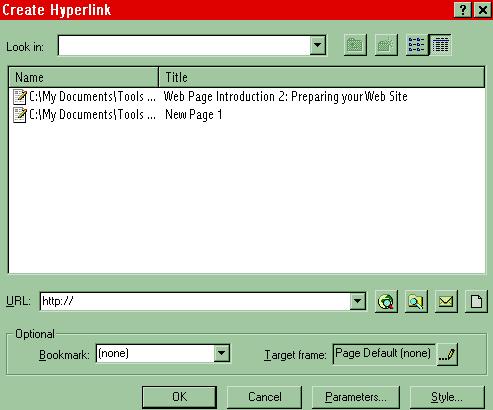
Go to the Dreamweaver version.
There are all kinds of links to consider.
Only the first three links in the above list are currently used in web page authoring.
Did you notice that you can link to a part of this page by clicking on one of the items in the list at the top? You can also click on the words "Back to top" and link back to the top (go figure). Well, those convenient links are anchor links in most web-authoring applications, but they are called bookmarks in FrontPage probably because Microsoft was being consistent with other Office applications where anchors are called bookmarks.
To set a bookmark, you need a long document like this one. You can make your document longer by pressing the Enter key to create blank spaces down the page. Every ten rows or so, enter some text to link to. To place your bookmarks, you simply place the cursor next to the section where you would like your visitors to end up and insert a bookmark by choosing "Insert" on the menu bar and selecting "Bookmark". A window opens asking you to name the bookmark.

Give your bookmark a name and hit OK. You can see in the example above that I've named a bookmark "Top".
In order to establish a link to a bookmark, select your text, click on the
link icon. ![]() The "Create
Hyperlink" window opens.
The "Create
Hyperlink" window opens.

At the bottom of this window you'll see the "Bookmark" drop-down menu. Select the bookmark you named previously and want to link to and hit OK. You can make many links to one bookmark. For example, in this page, there is a bookmark at the top called "Top" where all the "Back to top" links end up.
These are links to other pages in your website. A web site has more than one
page, and pages are all linked. When you upload your site, all your links become
addresses or URLs (Universal Resource Locators). Obviously, you can only link to
another page in your site if you actually have more than one page! So make
a new page right now. Go ahead. Give it a name like secondwebpage.htm and
save it to your web folder. Go back to your first page and link to that
page by typing some text like, "Go to my next page." Paint that text
and press the Link Icon ![]() or
Control K. The "Create Hyperlink" window opens and you click on
the second icon to the right of the URL box. Navigate to your folder that
contains the page in your site that you want to link to and hit OK.
or
Control K. The "Create Hyperlink" window opens and you click on
the second icon to the right of the URL box. Navigate to your folder that
contains the page in your site that you want to link to and hit OK.
Obviously, you want to save pretty regularly (Control + S). Don't say I didn't warn you.
If you think about it, you probably realize that anything you can select can also be a link. Hmmmmm! Does this mean images (including animated gifs and jpegs) can be selected and linked?
Add an image to your page and select it by clicking on it once. Click
on the Link Icon ![]() and link to
another page in your website.
and link to
another page in your website.
These are the world wide web links that are so cool because they connect your
site to the outside world. To make one, follow the same procedure as you did to
make a Site Link. Paint the text you want to link and click on the Link
Icon again. ![]() You already know the
"Create Hyperlink" window looks like this.
You already know the
"Create Hyperlink" window looks like this.

With "Create Hyperlink" window and your web browser open, click on the first icon to the right of the URL address box in the "Create Hyperlink" window. Now click on your browser window and go to a web site. When you return to FrontPage, you'll find that a link has already been inserted for the last URL you visited. You can also copy URLs from the Netscape or Explorer Location Bars and paste them to the URL box in the Create Hyperlink window. This saves time and eliminates keyboarding errors. "Copy and paste" is used a great deal in web page authoring.